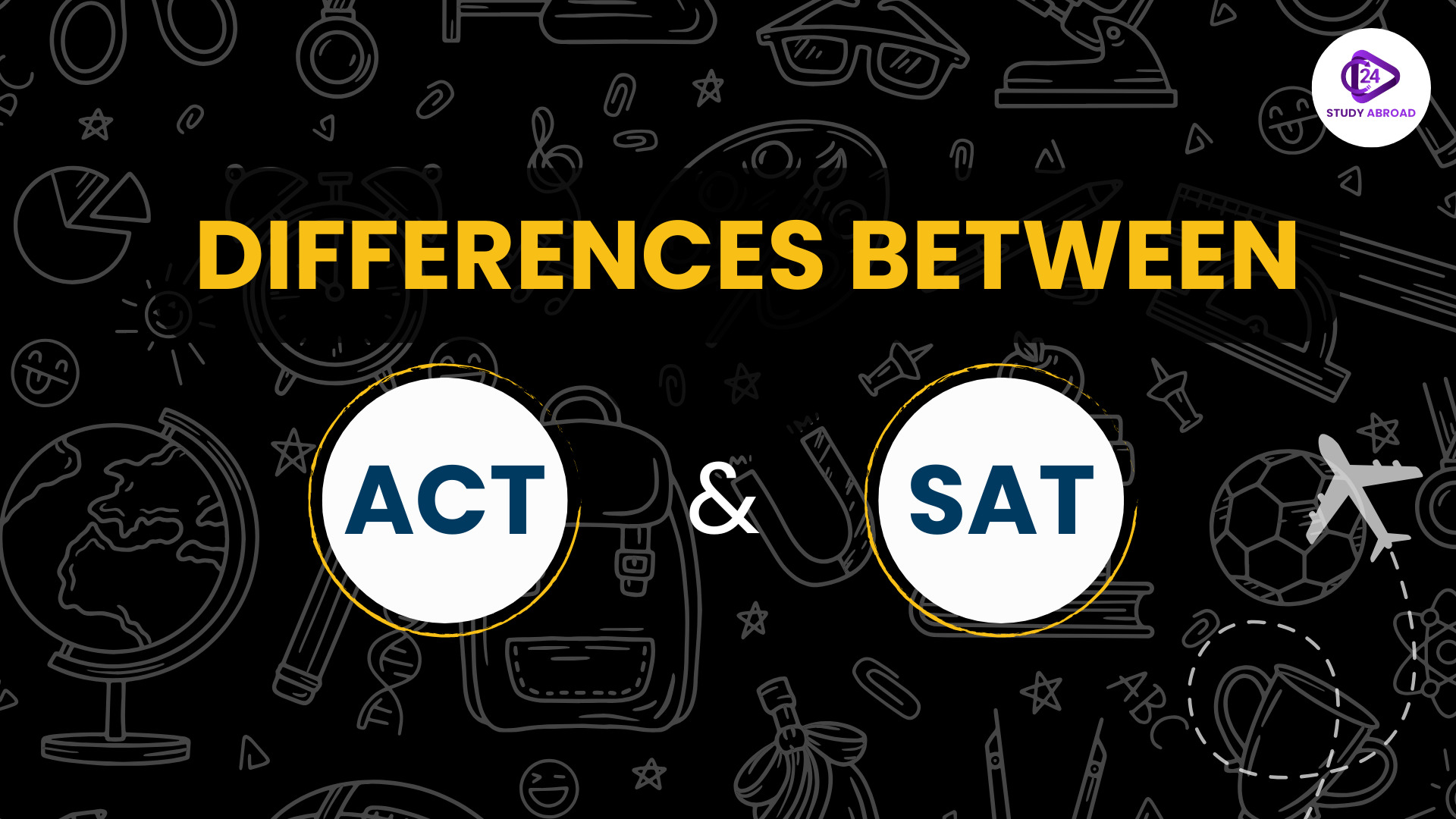Differences between ACT and SAT are one of the significant decisions students face when planning to study in the United States or other countries that accept these standardised test scores. Both exams aim to assess a student’s readiness for college, but they differ in many ways. The SAT focuses more on reasoning and problem-solving, while the ACT leans toward curriculum-based knowledge and a faster pace. Although both exams are widely accepted by universities in the US, Canada, and beyond, knowing the differences between ACT and SAT can help you align your strengths with the right exam. Whether it’s the format, timing, scoring system, fee structure, or subject emphasis, each test offers a unique experience. With millions of students taking the SAT and ACT each year, it’s essential to explore what sets them apart. In this guide, we break down all the key aspects of the differences between ACT and SAT to help you make a confident and informed choice.
Also Read: QS World University
Differences Between ACT and SAT Definitions
Understanding the differences between the ACT and the SAT begins with clear definitions. At their core, both exams evaluate college readiness, but they take distinct approaches shaped by their design and the specific measures they aim to assess. While the ACT emphasises curriculum-based knowledge, including science reasoning, the SAT focuses on critical thinking and problem-solving with digital enhancements. Let’s break down each test so you can see which aligns best with your skills and goals.
Also Read: Best UG Degree Study Abroad
What is the ACT Exam?
ACT (American College Testing) is a curriculum-based college admissions exam created by ACT, Inc. It measures mastery in English, mathematics, reading, and science, with an optional writing section and produces a composite score from 1 to 36. The exam typically lasts approximately 2 hours and 55 minutes (excluding breaks) and is available in both paper and computer formats.
As of April 2025, students taking the online version in the U.S. can choose to skip the science section; those who do will still receive a composite score alongside separate science results.
ACT Exam Full Form
ACT stands for ‘’American College Testing’’. It is a standardised test that students take to apply for undergraduate programs, especially in the U.S. ACT is a computer-based and paper-based test that covers four academic areas like English, math, reading, and science.
Also Read: Which Countries Accept NEET Scores for MBBS
What is the SAT?
SAT (Scholastic Assessment Test), developed and administered by the College Board. It assesses college readiness through evidence-based reading & writing and Math, with an optional essay in some formats. On the SAT exam, the total score ranges from 400 to 1600, combining the scores from both sections (Reading & Writing, and Math) to provide universities with a clear benchmark of academic skills. In 2024, the SAT transitioned to a fully digital format, which is shorter in length and offers faster score reporting. In this format, you are allowed to use calculators throughout the math. Students can either use the built-in calculator available in the Bluebook app or bring their calculator, as long as it’s on the approved list by the College Board.
SAT Exam Full Form
SAT stands for ‘’Scholastic Assessment Test’’. Students take the SAT test to show their college readiness and improve their chance of getting into top universities through two core sections: evidence-based reading & writing and math.
Also Read: Immigration Friendly Countries
Differences Between ACT and SAT Exam Format
Differences between ACT and SAT exam formats can make a big impact on your test-day experience. Both exams have evolved into shorter, more digital-friendly versions, yet they retain their distinct formats. The ACT emphasises multiple-choice across four core subjects, with an optional writing section and flexible science component, whereas SAT focuses on two main sections, with adaptive, digital modules for reading & writing and math. Below is a clear, up-to-date comparison of each test’s structure, which will help you to make a clear decision while choosing the correct format:
| Feature | ACT | SAT |
| Sections | English, Math, Reading, optional Science, optional Writing | Reading & Writing, Math |
| Test Format | Paper-based and computer-based | Digital-only |
| Test Durations | 2 hours 55 minutes (without writing)
3 hours 35 minutes (with writing) |
2 hours 14 minutes |
| Total Questions | 215 questions | 98 questions |
| Calculator Policy | Calculator allowed (not all types permitted) | Calculator allowed throughout |
| Scoring Scale | 1–36 (composite of 4 section scores) | 400–1600 (800 per section) |
| Test Frequency | 7 times a year | 5 times a year |
Also Read: How to Prepare for Study Abroad
Differences Between ACT and SAT Score and Conversion Guide
One of the key differences between ACT and SAT is how each test is scored and how those scores are interpreted. If you’re trying to see how your SAT and ACT scores stack up against each other, you can refer to the official conversion charts provided by the College Board and ACT, Inc. These charts will help you understand how a score from one test compares to scores from other tests.
Also Read: Country for MBBS for Indian Students
The SAT scores range from 400 to 1600, while the ACT composite scores range from 1 to 36. Always remember that the ACT’s optional writing section is scored separately and doesn’t count toward your composite score.
Below is a detailed breakdown of the scoring format and how ACT scores roughly convert to SAT scores.
| Exam | Total Score Range | Section Breakdown |
| ACT | 1-36 (composite) | English, Math, Reading, Science (1–36 each) |
| SAT | 400-1600 (total score) | Math (200–800), Reading & Writing (200–800) |
ACT to SAT Conversion
| ACT Composite | SAT Total Score (Approx.) |
| 36 | 1590-1600 |
| 34-35 | 1500-1580 |
| 31-33 | 1390-1490 |
| 28-30 | 1300-1380 |
| 24-27 | 1180-1290 |
| 21-23 | 1060-1170 |
| 18-20 | 970-1050 |
| 16-17 | 910-960 |
| 14-15 | 780-900 |
| 12-13 | 690-770 |
With this simple explanation of the differences between ACT and SAT score formats and conversions, you get the clarity to choose the proper test and set realistic score targets based on your college goals.
Also Read: Which Countries Accept NEET Scores for MBBS 2025?
Differences Between ACT and SAT Exam Fees
Another important factor when choosing between ACT and SAT exams is the fees. Along with exam patterns and score comparisons, understanding the fee structure is also an important factor. Here’s a quick look at the differences between ACT and SAT exam fees to help you plan your budget accordingly.
| Test | Basic Registration Fees (U.S. Students) | Basic Registration Fees (International Students) |
| ACT | $65 (without Writing)
$90 (with Writing) |
$65 + $60 international fee = $125
$90 + $60 = $150 (with Writing) |
| SAT | $68 | $68 + $43 international fee = $111 |
Differences Between ACT and SAT Registration Process 2025
When exploring the Differences Between ACT and SAT, it is crucial to understand the registration process. Both tests can be registered online, but they differ in deadlines, required materials, and regional procedures, especially important for students in India. Here, we provide an updated overview of how to register for each exam through its official platform in 2025.
Also Read: MBBS Abroad vs MBBS in India
ACT Registration Process (via ACT.org)
- Account setup: Create a MyACT student account on ACT.org and select “Outside the US” for international registration.
- Choose date & center: It is available in major Indian cities. View international test dates and registration deadlines in the official PDF calendar.
- Upload photo: when prompted (deadline aligns with registration cutoff).
- Select test options: Core test by default; opt into Writing (+ $25) or Science (+ $4, online April–July 2025) if desired.
- Payment: You can pay via credit/debit card, based at $65, plus any add-ons.
- Confirmation: You’ll receive an admission ticket via email; changes are allowed before deadlines.
Also Read: How to Study Abroad for Free
SAT Registration Process (via College Board)
- Account setup: Log in or create a My SAT account on CollegeBoard.org.
- Select location: Choose from 40+ Indian test centers via “Find a Test Center” tool.
- Choose date and device: Select a test date; if using your own device, you must prepare the Bluebook app in advance.
- Payment: For August 2025–June 2026 tests, the fee is $68, plus a $43 international surcharge. Payment can be made with a card or via PayPal.
- Confirmation: Submit your registration; you’ll receive a digital ticket and make changes before the deadline.
Also Read: Top Universities for MBBS Abroad
Differences Between ACT and SAT & What Do Top Universities Prefer?
One of the most common questions students ask when exploring the Differences Between ACT and SAT is whether colleges prefer one over the other. According to official sources, such as the College Board and ACT, Inc., no U.S. college gives preference to either test; they accept both equally for admissions.
If you’re applying to a university that does accept standardized test scores, you’ll likely see no stated preference for ACT over SAT or vice versa. That’s because these exams are designed to measure similar skills in different formats, and admissions teams are trained to evaluate both equally.
So, the decision is entirely in your hands. Select the test that best aligns with your academic strengths and test-taking style.
How to Decide?
Here’s a simple way to think about it:
- Choose ACT if you’re confident in Math and Science and can manage time well. The ACT includes a Science section and often requires faster problem-solving.
- Choose SAT if you’re more comfortable with Reading, Writing, and Basic Math. The digital SAT allows for a little more time per question and includes built-in tools, such as a calculator and formula sheet.
If you’re unsure which test to take, try a full-length practice test for both exams. This will help you understand which exam feels more natural.
Also Read: MBBS in Kazakhstan
Conclusion
When preparing for your study abroad journey, understanding the Differences Between ACT and SAT is one of the most critical steps. Top universities accept both tests equally, so choose the one that best suits your strengths and comfort level. If you’re strong in Math and Science, ACT might suit you better. If you prefer Reading and Writing, SAT could be the right fit. Check the format, fees, and registration process carefully before making a decision. Pick the test that helps you perform your best.
Differences Between ACT and SAT FAQs
Does SAT allow calculator use in the Math section?
Yes. SAT includes a built-in calculator for both modules.
Is the ACT Harder than the SAT?
The ACT isn’t necessarily more complicated than the SAT. It depends on your strengths. ACT has faster timing and includes a Science section, while SAT allows more time per question and focuses more on reading and writing. Choose based on your comfort level.
What is the difference between SAT and ACT reading?
The main difference between SAT and ACT reading is the format and pacing. SAT reading includes shorter passages with a greater focus on evidence-based questions and provides more time per question. ACT reading passages are longer and focus more on overall comprehension and inference.
Are both tests accepted by U.S. colleges?
Yes, all major U.S. colleges treat SAT and ACT equally. Many universities have adopted a test-optional, and universities use conversions if needed.
Do either exam deduct marks for wrong answers?
No. Both SAT and ACT have no penalty for wrong answers.





















